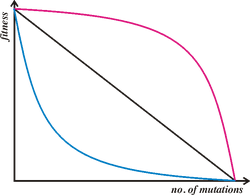Assessment |
Biopsychology |
Comparative |
Cognitive |
Developmental |
Language |
Individual differences |
Personality |
Philosophy |
Social |
Methods |
Statistics |
Clinical |
Educational |
Industrial |
Professional items |
World psychology |
Biological: Behavioural genetics · Evolutionary psychology · Neuroanatomy · Neurochemistry · Neuroendocrinology · Neuroscience · Psychoneuroimmunology · Physiological Psychology · Psychopharmacology (Index, Outline)
Epistasis takes place when the action of one gene is modified by one or more others that assort somewhat independently. (The two genes may be quite tightly linked, but their effects must reside at different loci in the genome). Examples of tightly linked genes having epistatic effects on fitness are found in supergenes and the human major histocompatibility complex genes). The effect can occur directly at the genomic level, where one gene could code for a protein preventing transcription of the other gene. Alternatively, the effect can occur at the phenotypic level. For example, the gene causing albinism would hide the gene controlling color of a person's hair. In another example, a gene coding for a widow's peak would be hidden by a gene causing baldness. Fitness epistasis (where the affected trait is fitness) is the cause of linkage disequilibrium.
Epistasis and genetic interaction refer to the same phenomenon; however, epistasis is widely used in population genetics and refers especially to the statistical properties of the phenomenon.
Studying genetic interactions can reveal gene function, the nature of the mutations, functional redundancy, and protein interactions. Because protein complexes are responsible for most biological functions, genetic interactions are a powerful tool.
Classification by fitness or trait value[]

Diagram illustrating different relationships between numbers of mutations and fitness. Synergistic epistasis is represented by the red line - each mutation has a disproproportionately large effect on the organism's fitness. Antagonistic epistasis is the blue line.
Two-locus epistatic interactions can be either synergistic (positive) or antagonistic (negative). In the example of a haploid organism with genotypes (at two loci) AB, Ab, aB and ab, we can think of the following trait values (the exact values are simply given as examples):
| AB | Ab | aB | ab | |
| No epistasis (additive across loci) | 2 | 1 | 1 | 0 |
| Synergistic epistasis | 3 | 1 | 1 | 0 |
| Antagonistic epistasis | 1 | 1 | 1 | 0 |
Hence, we can classify thus:
| Trait values | Type of epistasis |
| AB = Ab + aB - ab | No epistasis, additive inheritance |
| AB > Ab + aB - ab | Synergistic epistasis |
| AB < Ab + aB - ab | Antagonistic epistasis |
Understanding whether the majority of genetic interactions are synergistic or antagonistic will help solve such problems as the evolution of sex.
Functional or mechanistic classification[]
- Suppression - the double mutant is wild type
- Synthetic lethality - the double mutant is lethal
- Intragenic complementation - two mutations cause similar phenotypes and map to the same locus yet show complementation in heterozygotes.
- Unlinked non-complementation - two mutations fail to complement but do not map to the same locus
Example in Mendelian terms[]
In a more detailed example, consider the sweet pea plant. In a simple representation, purple flower color (P) is dominant over white (p). However, consider the addition of a control gene, consisting of two alleles, dominant (C) or recessive (c). In this example, for the flowers to be purple, the plant must have at least one of each dominant allele (i.e. it must be P-C-, where the "-" can be either dominant or recessive).
In a dihybrid cross, such as the pea plant example above, when there is a genetic interaction involved, you often see a modified 9:3:3:1 ratio. Normally, when you have two alleles which assort independently, you get a 9:3:3:1 ratio of phenotypes. Genetic interactions, however, can conceal the ratio, and make it appear to be something other. In the example of the pea plants above, the result is a 9:7 ratio of purple to white phenotypes instead of the expected 12:4 ratio.
See also[]
The development of phenotype
|
|---|
| Key concepts: Genotype-phenotype distinction | Norms of reaction | Gene-environment interaction | Heritability | Quantitative genetics |
| Genetic architecture: Dominance relationship | Epistasis | Polygenic inheritance | Pleiotropy | Plasticity | Canalisation | Fitness landscape |
| Non-genetic influences: Epigenetic inheritance | Epigenetics | Maternal effect | dual inheritance theory |
| Developmental architecture: Segmentation | Modularity |
| Evolution of genetic systems: Evolvability | Mutational robustness | Evolution of sex |
| Influential figures: C. H. Waddington | Richard Lewontin |
| Debates: Nature versus nurture |
| List of evolutionary biology topics |
de:Epistase lv:Epistāze sr:Интеракције гена
| This page uses Creative Commons Licensed content from Wikipedia (view authors). |